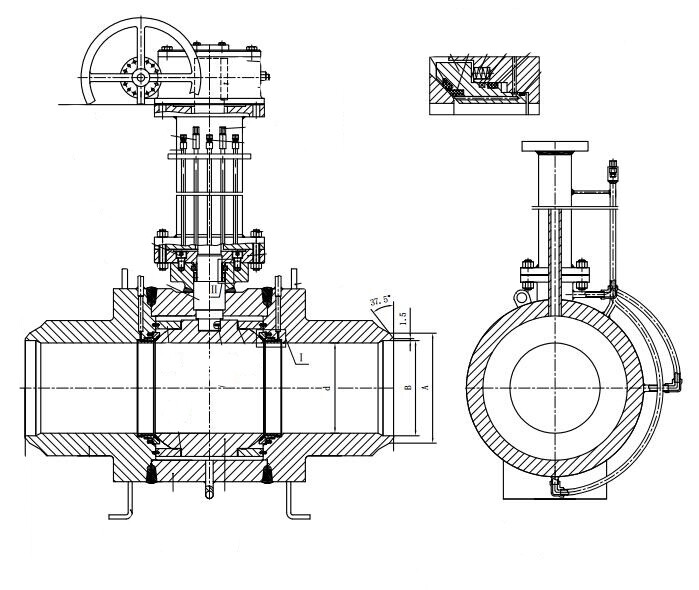Efficient Operation and Selection of Underground Ball Valves
Underground ball valves are pivotal components in industrial and pipeline systems, yet they frequently encounter operational issues. This article delves into common failures and their corresponding remedies for underground ball valves, along with guiding principles for selecting the most suitable ball valves.

Common Failures and Remedies
During operation, underground ball valves often suffer from external leakage due to packing wear and internal leakage caused by damage to the valve seat seal.
1. External Leakage from Packing Wear: Packing wear can lead to loosening of the packing gland, resulting in leakage. Initially, attempting to tighten the packing gland may resolve the issue. Persistent leakage indicates that the packing has lost elasticity and requires complete replacement.
2. Packing Compression Techniques: Proper packing compression involves symmetrically tightening gland bolts to prevent tilting and allowing space for compression. Simultaneously, rotating the valve stem ensures even compression of the packing, preventing overtightening, which could impede stem rotation, increase packing wear, and shorten the valve's lifespan.
3. Damage to Valve Seat Seal: Damaged seal rings necessitate prompt replacement, especially for plastic valve seats. Minor damage to metal-to-metal sealing surfaces (less than 0.05mm depth) may be addressed through grinding. However, deeper damage requires machining before grinding or complete replacement. Grinding of the ball, occasionally needed with metal valve seats, can be accomplished using grinding sleeves or tools with concave ball surfaces.
2. Packing Compression Techniques: Proper packing compression involves symmetrically tightening gland bolts to prevent tilting and allowing space for compression. Simultaneously, rotating the valve stem ensures even compression of the packing, preventing overtightening, which could impede stem rotation, increase packing wear, and shorten the valve's lifespan.
3. Damage to Valve Seat Seal: Damaged seal rings necessitate prompt replacement, especially for plastic valve seats. Minor damage to metal-to-metal sealing surfaces (less than 0.05mm depth) may be addressed through grinding. However, deeper damage requires machining before grinding or complete replacement. Grinding of the ball, occasionally needed with metal valve seats, can be accomplished using grinding sleeves or tools with concave ball surfaces.
Principles for Selecting Underground Ball Valves
Selecting the appropriate underground ball valve is crucial for ensuring the efficiency, safety, and longevity of pipeline systems. The following principles outline key considerations for making informed decisions:
- Main Pipeline Transport: Buried main pipelines, such as those for oil and natural gas, benefit from full-bore and fully welded ball valves. Surface pipelines can utilize fully welded or flanged ball valves. Branch lines are suited to flanged, welded, full-bore, or reduced-bore ball valves.
- Transport of Refined Oil: Refined oil transport pipelines and storage facilities require flanged ball valves.
- City Gas and Natural Gas Pipelines: Floating ball valves with flanged and internal threaded connections are suitable for city gas and natural gas pipelines.
- Oxygen Pipeline Systems: Metallurgical oxygen pipeline systems should use rigorously degreased, flanged, fixed-ball valves.
- Low-Temperature Media: Low-temperature ball valves with valve covers are recommended for pipelines and equipment handling low-temperature media.
- Catalytic Cracking Units: Refinery catalytic cracking unit pipelines may benefit from lift rod ball valves.
- Chemical Systems: Stainless steel ball valves with austenitic stainless steel construction and PTFE seat seals are advisable for chemical systems handling corrosive media like acids and alkalis.
- High-Temperature Media: Metal-to-metal sealed ball valves are suitable for high-temperature media pipelines or equipment in metallurgical, power, petrochemical, and urban heating systems.
- Flow Regulation: For flow regulation requirements, ball valves with worm gear, pneumatic, or electric actuators and V-shaped openings are recommended.
In conclusion, understanding and addressing common failures, implementing appropriate remedies, and adhering to selection principles are crucial for optimizing the efficiency and reliability of underground ball valves in industrial pipeline systems. By applying these insights, stakeholders can enhance operational performance and ensure long-term success.

